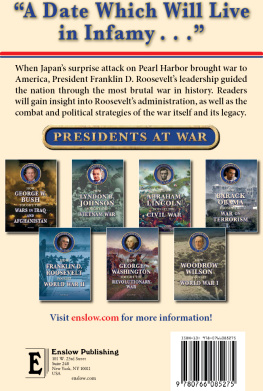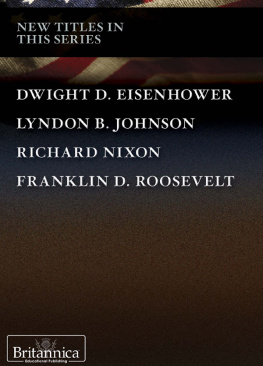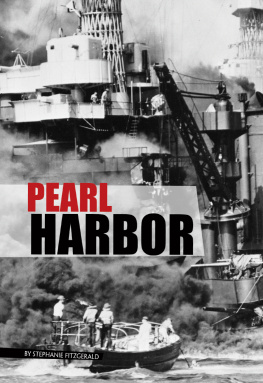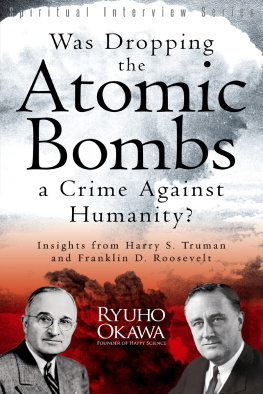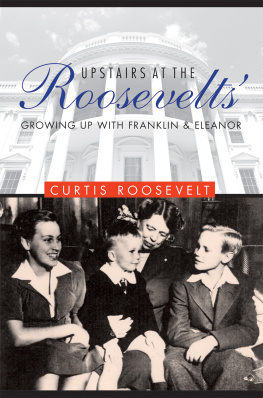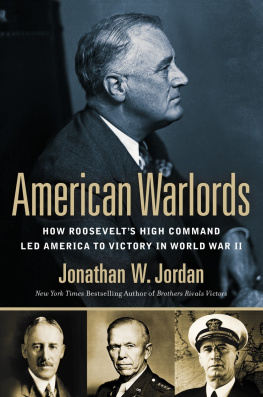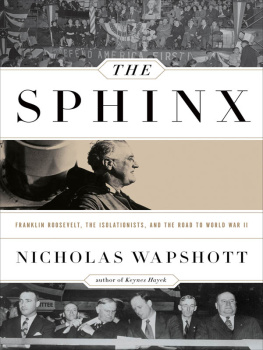Published in 2018 by Enslow Publishing, LLC.
101 W. 23rd Street, Suite 240, New York, NY 10011
Copyright 2018 by Enslow Publishing, LLC.
All rights reserved.
No part of this book may be reproduced by any means without the written permission of the publisher.
Library of Congress Cataloging-in-Publication Data
Names: Rice, Earle, author.
Title: How Franklin D. Roosevelt fought World War II /Earle Rice Jr.
Description: New York : Enslow Publishing, 2018. | Series: Presidents at war | Includes bibliographical references and index. | Audience: Grades 7-12.
Identifiers: LCCN 2017004612 | ISBN 9780766085275 (library bound)
Subjects: LCSH: Roosevelt, Franklin D. (Franklin Delano), 18821945Juvenile literature. | PresidentsUnited StatesBiographyJuvenile literature. | United StatesPolitics and government19331945Juvenile literature. | World War, 1939-1945United StatesJuvenile literature.
Classification: LCC E807 .R49 2017 | DDC 973.917092dc23
LC record available at https://lccn.loc.gov/2017004612
Printed in the United States of America
To Our Readers: We have done our best to make sure all website addresses in this book were active and appropriate when we went to press. However, the author and the publisher have no control over and assume no liability for the material available on those websites or on any websites they may link to. Any comments or suggestions can be sent by email to .
Photo Credits: Cover, pp. John Stevenson/Corbis Historical/Getty Images.
INTRODUCTION
CHAPTER 1 DATE OF INFAMY
CHAPTER 2 PATH TOWARD DISASTER
CHAPTER 3 THE WINDS OF WAR
CHAPTER 4 AMERICAS UNDECLARED WAR
CHAPTER 5 AMERICA JOINS THE FIGHT
CHAPTER 6 A WORLD AT WAR
CHAPTER 7 TURNING THE TIDE
CHAPTER 8 TRIUMPH AND TRAGEDY
CHAPTER 9 ENDGAME IN THE PACIFIC
CHAPTER 10 RAIN OF RUIN
CONCLUSION
CHRONOLOGY
CHAPTER NOTES
GLOSSARY
FURTHER READING
INDEX
Young Franklin is age eleven in this portrait, where he is shown holding hands with his mother, Sara Delano Roosevelt.
INTRODUCTION
F ranklin Delano Roosevelta man destined to guide the free world through its most devastating conflictentered a world of privilege in the Hudson Valley town of Hyde Park, New York, on January 30, 1882.
Born into a wealthy old-Dutch family from Dutchess County, New York, Rooseveltwidely known as FDR was educated at Groton School and Harvard College in Massachusetts. At Groton, he ranked fourth in a class of nineteen. He graduated in the spring of 1900. FDR excelled in extracurricular activities while at Harvard but maintained only average grades. The future world leader graduated with a bachelor of arts degree in history in 1903.
While still in college, FDR began courting Anna Eleanor Roosevelt, his fifth cousin once removed. She was the niece of their mutual uncle, Theodore Roosevelt, the twenty-sixth president of the United States. Franklin married Eleanor in 1905. Their union produced six children, a daughter and five sons, one of whom died in infancy. Over time, they drifted apart. They remained married but detached.
Roosevelt entered Columbia Law School in New York City in 1904 but dropped out after passing the New York State bar examination in 1907. He soon embarked on a career of public service. In 1910, he ran for, and was elected to, the New York State Senate. En route to high office, he subsequently served as assistant secretary of the Navy in World War I. FDR was later elected governor of New York in 1929.
In 1932, despite a polio-induced paralysis from the waist down at the age of thirty-nine, FDR reached the pinnacle of American politics with his election as president of the United States. He assumed the office and its burdens amid depression at home and discontent abroad. The collapse of Wall Street in 1929 had undermined the American economy. Millions of workers lost their jobs, homes, and savings in the Great Depression that followed. Economic and political unrest abroad posed a further threat to the stability of the American way of life.
At his inauguration address, Roosevelt set about immediately to calm the collective apprehension of all Americans at a turning point in world history. In his silvery oratorical style, he offered assurance that the nation was in steady hands. [F]irst of all, let me assert my firm belief, he said, that the only thing we have to fear is fear itself. He spoke for fifteen minutes and instilled confidence in a nation desperate for leadership.
Throughout the 1930s, Roosevelt worked tirelessly to heal Americas wounded economy, passing monumental legislation under the umbrellas of the New Deal and the Second New Deal. As war clouds gathered abroad, he artfully maneuvered US foreign policy to maintain American neutrality, while concurrently preparing his nation for war.
During those tumultuous years, FDR formed a friendship and high regard for Great Britains prime minister Winston Churchill. Together, they forged an alliance later joined by Premier Joseph Stalin of the Soviet Union (USSR)that would defeat Germany and Japan and restore order in the postwar world.
DATE OF INFAMY
A mericas entry into World War II began on a tranquil Sunday morning at a faraway setting in the mid-Pacific Ocean. It began on a small island that had beenup till thena paradise of sorts, basking in warm sunlight and cooled by fragrant breezes. It began at precisely 7:55 a.m. At that moment, a wave of Japanese aircraft appeared over Oahu in the Hawaiian Islands and launched a surprise attack on the US naval base at Pearl Harbor and other US military installations on the island. Over the next two hours, the lives of all Americans would be forever altered. It was December 7, 1941.
Twelve days earlier, at dawn on November 26 (Japan time), ships of Japans First Air Fleet put to sea out of Hitokappu Bay (now Kasatka Bay) in Itorofu (now Iturup), one of the Kuril Islands. The fleetalso called Kido Butai (Striking Force)sailed under the command of Admiral Chuichi Nagumo of the Imperial Japanese Navy (IJN).
Once clear of Hitokappu, Nagumo set a northern course and plowed into the choppy seas of the mist-and-fog-shrouded North Pacific where commercial vessels seldom ventured. En route to his assigned destination, he would have many lonely hours to ponder his final instructions from Admiral Isoroku Yamamoto, commander in chief of the Japanese Combined Fleet: In case negotiations with the United States reach a successful conclusion, the task force will immediately put about and return to the homeland.
The US destroyer Shaw erupts in a billowing array of flame and smoke after Japanese bombs strike its ordnance and touch off a devastating explosion.

